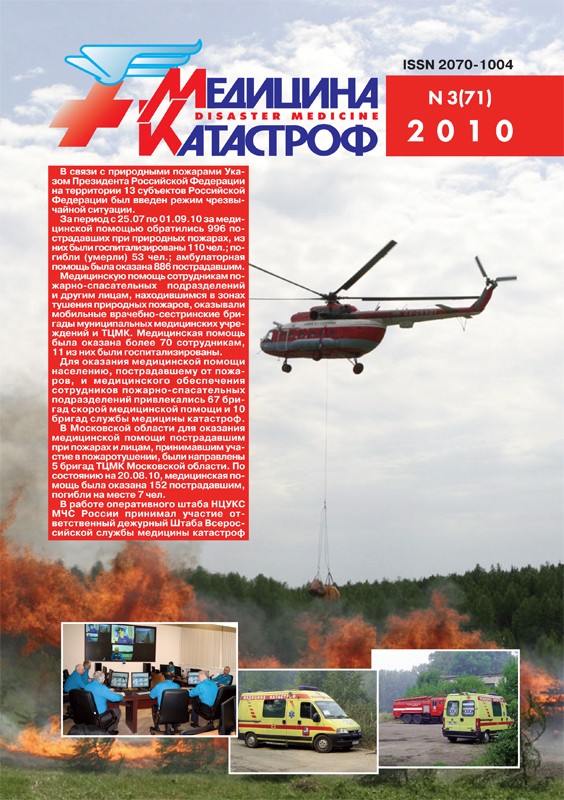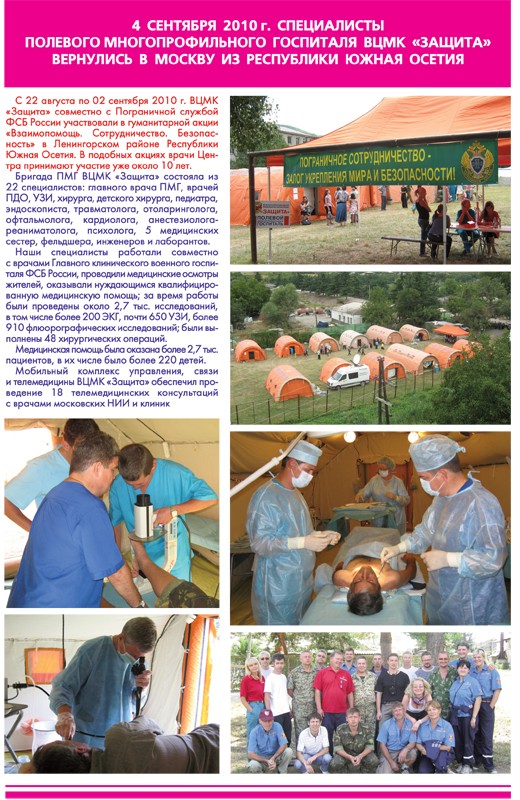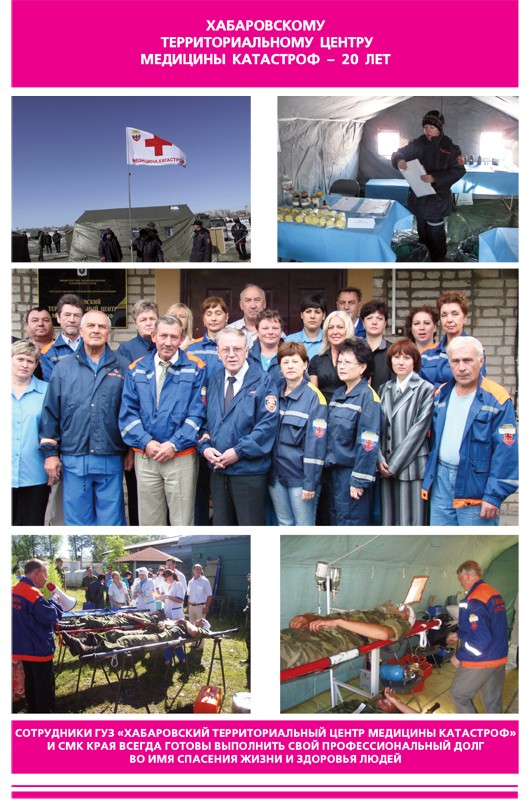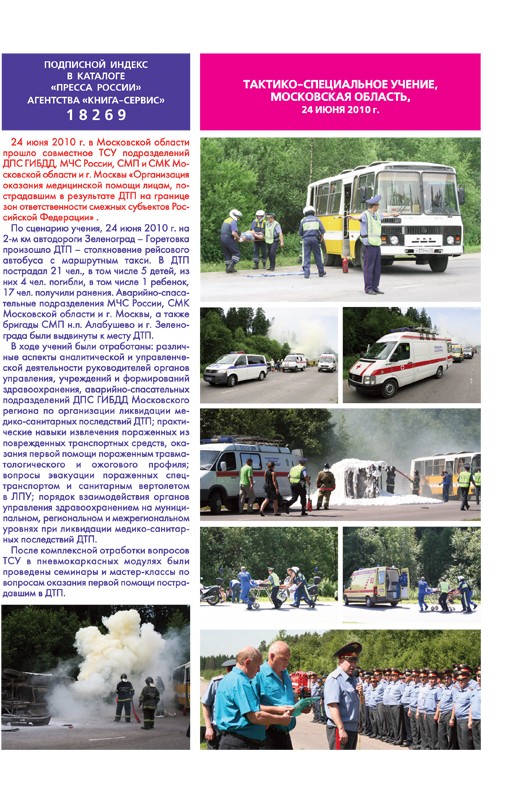ORGANIZATION AND TACTICS OF DISASTER MEDICINE SERVICE
1. Borisenko L.V., Akin’shin A.V., Chernyak S.I. First Aid: Changes in Current Law and Ways of Solving New Problems
The changes introduced into laws regulating provision of first aid to casualties are presented. A new definition of the notion «first aid» stipulated by the law of the Russian Federation on health care is given. Three stages of activity on perfection of first aid rendering to casualties are defined. A suggestion is made and substantiated on need of elaboration of Federal target program «First Aid». Some results of realization in 2006–2009 of Federal target program «Improved Road Safety 2006–2012» are summed up.
Key words: casualties, federal bill on changes in law on first aid, Federal target program «First Aid» (draft), first aid, «Improved Road Safety 2006–2012», road traffic accidents
2. Alexanin S.S., Astafiev O.M., Sannikov M.V. Perfection of System of Medical Examination of Rescuers and Firemen of Ministry of Emergency Situations of Russia
The analysis of health status of rescuers and firemen based on morbidity with temporal disability statistics and on the results of thorough health check-ups at the clinic of All-Russian Center for Emergency and Radiation Medicine named after A.M.Nikiforov. The leading groups of diseases of people in hazardous occupations are identified. It is stated that these diseases are mainly the result of stress consequences and of direct influence of occupational factors. Suggestions are made on optimization of the system of medical status check-ups of rescuers and firemen due to thorough examination at occupational pathology divisions of the Center and its branches once every 3 years.
Key words: firemen, health status, rescuers, system of medical check-ups, thorough health check-ups
3. Lobanov A.I. Lessons Learnt and Conclusions Drawn from Experience of Organization of Medical Support in Mass Heat Injuries Incidents
The course and results of liquidation of medical and sanitary consequences of crash of two passenger trains near Ufa (1989) and of a fire in a night club in Perm (2009) are analyzed.
The conclusions from the experience of medical support management in case of mass heat injuries are presented.
Key words: casualties, fire in night club in Perm, mass heat injuries, medical support management, mortality, trains crash near Ufa
4. Efremenko S.V., Azovsky D.K., Karpanina Yu.N. Interhospital Patient Transfer: History and Current Status
The origin of the idea of interhospital patient transfer as a component of medical care process, interhospital patient transfer development and perfection of the transportation means used are described. The national and international experience in the field are shown. The key principles of interhospital patient transfer and the main requirements and recommendations for its enhancement based on the best practices are set out.
Key words: aero-medical aircraft equipment, interhospital patient transfer, medical aviation, requirements to interhospital patient transfer
CLINICAL ASPECTS OF DISASTER MEDICINE
5. Sharshov F.G., Spiridonova E.A., Rumyantsev S.A., Rostorguyev Eh.V., Prometnoy D.V., Chernozubenko A.V. Work Protocol for Delivery of Emergency Medical Care to Children with Severe Traumatic Injuries of Resuscitation and Consultation Center of Rostov Oblast Service for Disaster Medicine
A protocol is presented of consultative management of children with severe traumatic injuries elaborated at Resuscitation and Consultation Center of Rostov Oblast Service for Disaster Medicine. The protocol determines the algorithm of actions of medical personnel. The contents of the protocol that makes it possible to optimize the work of the Center when rendering emergency medical care to children with severe traumatic injuries is discussed.
Key words: children with severe traumatic injuries, consultation protocol, emergency medical care, resuscitation and consultation center, Rostov Oblast Service for Disaster Medicine
6. Boyarintsev V.V., Yudin A.B., Nazarov V.B., Samoylov A.S., Fronchek Eh.V., Kovalenko R.A. Nonclinical Evaluation of Efficiency of Topical Hemostatic Agents (Experimental Research)
The results are presented of a comparative study of hemostasis efficiency of different agents on protracted arteriovenous bleeding. A conclusion is drawn that such agents are efficient in controlling protracted arteriovenous bleeding and allow to significantly cut mortality. It is found that «Hemostop» (Scientific-Production Center «Farmzashchita») is the most promising of the 4 agents tested since its use with similar primary hemostasis efficiency prevents rebleeding.
Key words: bleeding, experimental research, hemostasis, nonclinical evaluation, prehospital stage, topical hemostatic agents
7. Puras Yu.V., Talypov A.Eh. Impact of Prehospital Stage Arterial Hypotensia on Surgical Results of Management of Casualties with Severe Craniocerebral Traumas
The results of a research aimed at assessment of impact of prehospital stage arterial hypotensia on surgical results of management of casualties with severe craniocerebral traumas are presented. A conclusion is drawn that presence of episodes of arterial hypotensia at prehospital stage significantly aggravates the outcome. It is noted that duration of the episodes upwards of 20 minutes and drop of systolic blood pressure below 80 mmHg are prognostically negative factors.
Key words: arterial hypotensia, casualties with severe craniocerebral traumas, prehospital stage, surgical management, systemic hemodynamic dysfunction, systolic blood pressure
8. Neroev V.V., Gundorova R.A., Alexeeva I.B., Galchin A.A. Eye Functional Recovery: Ways and Directions of Further Work on Eye Trauma Problem
A scheme of functional recovery of an eye after severe trauma and its consequences is presented. The scheme elaboration is based on materials of observation of 1585 cases with severe eye trauma and 1250 patients with severe trauma consequences and initial subatrophy. The patients were under treatment at Moscow Scientific and Research Eye Institute named after Helmholtz. A conclusion is drawn that functional recovery of eyes is one of the most important directions of rehabilitation of casualties with eye traumas.
Key words: casualties with severe eye traumas, eye functional recovery, factors and stages of recovery therapy, rehabilitation
9. Lartsev M.A., Metlyaeva N.A., Shcherbatykh O.V. Ways of Perfection of Medical and Psychophysiological Support of Personnel of Facilities Using Atomic Energy
The review and history are presented of substantiation and development of system of psychophysiological support of activity of personnel of hazardous facilities. The special attention is paid to psychophysiological occupational selection of personnel for such facilities. The wide experience of study of psychophysiological aspects of liquidation of medical and sanitary consequences of Chernobyl accident, that enabled the authors to substantiate and present the ways of further perfection of the system of medical and psychophysiological support of personnel functioning in specific sphere where “human factor” is one of the major considerations in securing accident free operation.
Key words: medical support, operational faults, people of hazardous occupations, personnel of facilities using atomic energy, psychophysiological check up, psychophysiological support, radiation accidents
10. Bubeev Yu.A., Kal’manov A.S., Kotrovskaya T.I. Use of Subnarcotic Xenon-Oxygen Gas Mixture for Correction of Functional Status of Those in Hazardous Occupations
The effects are studied of inhalation use of subnarcotic xenon-oxygen gas mixture by people subjected to permanent physical and psychoemotional stress and consequently in state of lower-level functional status.
It is shown that inhalation of the mixture had a pronounced analeptic effect, led to functional status enhancement and normalization of their psychophysiological status, to better subjective state, higher performance efficiency.
A conclusion is drawn on promising outlook of xenon-based gas mixtures use for functional status correction of people in hazardous occupations.
Key words: functional status correction, people in hazardous occupations, subnarcotic xenon-oxygen gas mixture
11. Fisun A.Ya., Perekhodov S.N. Pain Syndrome in Emergency Situation Casualties: Current Approaches to Management and Prophylactics
Present-day views on possibilities of management of pain syndromes in casualties of emergency situations are presented and mechanisms of pain formation, pharmacotherapeutic effect of opioids and their side effects are analyzed. A substantiation is presented of use of tramadol for treatment of moderate and acute pain syndrome in casualties of emergency situations.
Key words: management of pain syndrome, tramadol hydrochloride
MEDICAL ASPECTS OF ROAD TRAFFIC SAFETY
12. Tsap N.A., Popov V.P. Organization of Specialized Medical Care to Pediatric Traffic Accident Casualties on Sverdlov Oblast Highways
The issue of pediatric trauma resulting from road traffic accidents in the region with an extensive network of regional and federal highways is given consideration.
Absolute figures of accidents with children involved in the territory of the oblast are presented and the analysis of losses in pediatric casualties with the place of death of casualties as the criterium is done. The conclusion is drawn that the optimal procedure of rendering emergency medical care to pediatric traffic accident casualties is on-the-spot medical care provided by teams of highway first aid stations or ambulance crews followed by aeromedical evacuation by pediatric teams to the stage of specialized medical care that is to the 9th Children’s City Clinical Hospital of Yekaterinburg.
Key words: children, highways, prehospital stage, road traffic accidents, specialized medical care, Sverdlov Oblast
13. Yandiev S.I. Closed Intramedullary Osteosynthesis of Femoral Fractures in Pediatric Road Traffic Accident Casualties
The results of 225 operations on diaphyseal fractures in pediatric traffic accident casualties are analyzed. In most cases (139 children, 146 operations) a closed intramedullary osteosynthesis was performed.
The conclusion is drawn that different varieties of intramedullary osteosynthesis are optimal in pediatric cases.
Key words: children, closed intramedullary oteosynthesis, diaphyseal femur fractures, femur, road traffic accidents
EDUCATION AND TRAINING OF PERSONNEL
14. Ryabinkin V.V. Professional Training of Personnel for All-Russian Service for Disaster Medicine (Present State and Prospects for the Future)
An analysis of the system of professional training of medical cadres for All-Russian Service for Disaster Medicine is done. Current problems of postgraduate training of specialists for disaster medicine are given consideration and the ways of their solution are shown.
Key words: All-Russian Service for Disaster Medicine, central bases for training, local training bases, professional training
15. Kosmodem’yansky L.V., Bashir-Zade T.S. Body System Interaction: Theory and Practice of Health Status Estimation and Correction for People in Hazardous Occupations
A conceptual model is presented of health status estimation and correction for people in hazardous occupations based on analysis of body system interaction. It is noted that the advantage of the approach is in the possibility of diagnosing functional disorders at their early stage by evaluation of agreement in interaction of «key» and «secondary» elements of a functional system. It is stressed that diagnostics results enable specialists to choose technologies of professional health correction, the leading ones of them being directed towards normalization of system interaction.
Key words: body system interaction, correction, functional systems, people in hazardous occupations, professional health, system approach, traditional diagnostics and treatment methods
JUBILEES
16. Shestopalov N.V., Sakharova O.A. Territorial Center for Disaster Medicine of Altai Territory is 10 Years Old
17. Porotikov V.T. Territorial Center for Disaster Medicine of Khabarovsk is 20 Years Old




